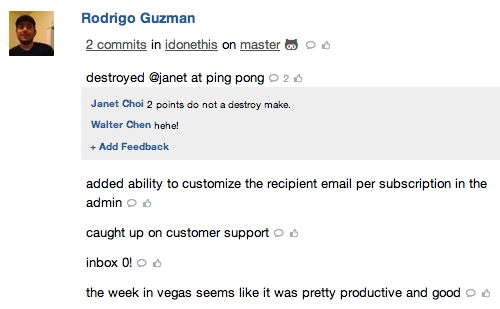This story is inspired by this week’s Startup Edition question:
How do you effectively work with remote teams?

The biggest challenge of working in remote teams isn’t dealing with the physical distribution of your teammates but reducing the psychological distance between everyone. Bridging that distance is probably a test for all types of teams but requires more work as a remote team.
“One thing that excites me about building a company is the human experience of making something out of nothing together,” our co-founder and CEO Walter recently wrote in a company email. As a distributed company, we have to sweat to achieve that communal sense of creation, but in doing so, we’ve had to consider and resolve aspects of our work culture with deliberation.
Culture takes shape from a sense of coherence, built through shared experiences, expectations, and values — and one key to cohering is learning how to communicate effectively with each other. I wanted to dig deeper into what we’ve learned about remote team communication that deals with building those shared relationships, expectations, and values and that help shape the cultural foundation of how we get stuff done.
1. Make sure that you’re closing the loop.
One of the great advantages of remote teams is the ability to work asynchronously, giving people the time and space to focus without disruption. However, with asynchronous communication, it’s tough to settle the problem of discovering you’ve sent a message out into the void.

At one point, Ginni, our Chief Happiness Officer, was constantly frustrated because engineers weren’t responding to and resolving their customer support emails quickly enough. Tickets demanding technical expertise sat as Ginni kept sending reminder emails and nudges in chat. What made the problem worse was that Ginni, like anyone would, hated nagging and feeling like she wasn’t being supported.
When we discussed the issue in person at a recent team retreat, we discovered where our remote team communication was breaking down. To the engineers, a ticket assignment in HelpScout looked like just another email in your inbox, which was too easy to put on the back burner.

We settled on creating issues in GitHub for now. Since the engineers spent most of the day there already, switching gears to customer support is easier. They could also prioritize and make sense of the tickets because the description of specific technical problems could be seen and understood at a glance.
Even though this created another step for Ginni’s workflow, it ultimately saved her time, improved our customer support as a whole, and Ginni didn’t have to feel ignored. This problem might not seem to be one of remote team communication. It’s not confusing to get assigned a support ticket, but that doesn’t make a message sent and received. The communication loop had never quite closed.
The increased responsibility to communicate well in remote teams falls to both the speaker/sender and the listener/receiver, especially with such dependence on written correspondence. On the one hand, writing something down in a shared space doesn’t necessarily mean you’re communicating well, and on the other, you have to make sure you’re not leaving your teammates hanging.
2. Always have a clear purpose for any remote team communication tool or process.
The best remote teams aim to overcommunicate. They use an arsenal of remote team communication tools to make up for how information travels around an office, providing channels for the various types of conversation that take place in different spaces, such as brainstorming around the whiteboard or chatting in the break room. The calculation of which tools and processes to use as a remote team requires understanding their roles and functions.
For awhile, we fell into a bad habit of holding weekly meetings over Google Hangout because we skipped the calculation. We knew that regular face-to-face contact was important for building camaraderie, and regularly checking in as a team seemed like something we should be doing. But that was neither clear nor compelling enough.

Since we didn’t set forth a specific enough protocol or purpose, the Hangouts were unfocused, devolved into rambling discussions about product, and ended up wasting our time. Nobody stepped up to provide direction, largely because it was hard to tell why we were having meetings in the first place. They were vaguely characterized as a weekly standup but we ended up rehashing what we were already sharing in iDoneThis.
Instead, we moved to frame our weekly calls as a Friday “Show and Tell”. The purpose and protocol is clear — each person spends a few minutes demonstrating some work that they’re proud of or sharing something noteworthy about the week. It’s an opportunity to celebrate our wins, see visuals and demos of progress, and shift mental gears into a more proactive mode so that everyone has something to show every week.
Bad remote team communication habits such as holding pointless meetings or implementing time-wasting tools happen all the time, no matter what structure you have. Still, as a remote team, you’re always looking for tools and ways to enrich remote team communication. It’s imperative to think first about the why and how and to unpack any practice you think you should be doing.
3. Make room for emotional conversations.
Informal conversations are more difficult and important than you might think when it comes to co-worker communication. Most remote teams use tools like HipChat or Campfire for water-cooler conversation, where off-topic jokes, banter, and chatter can take place in addition to work-related discussion.

But the more interesting thing we’ve found is that emotional conversations are really hard as a remote team.
Emotional conversation isn’t all heart-to-hearts (though those can certainly count) — but the communication of emotional context, which is often non-verbalized or falls outside the informal conversation of collective water-cooler chat.
Getting in the habit of exerting yourself to share how you’re feeling — not to mention getting comfortable with it — is quite difficult. And it’s pretty hard to understand your co-workers’ emotional state if they don’t actively communicate them. This is why video chats and in-person get-togethers remain so crucial for distributed teams, to gain a sense of who you work with every day as human beings and to build the trust and relationships that will help enable those emotional conversations.

We’re also getting better at recording more emotional context and informal conversation in iDoneThis rather than a straightforward list of what we get done. If I’ve expressed downer sentiments for a few days in a row, Walter or Rodrigo will bring it up in my weekly one-on-one, someone will write an encouraging comment, or Ginni will offer to co-work with me since we’re both located in New York.
Emotional communication and how we deal with each others’ feelings is a tremendous part of building morale, a sense of togetherness, and culture — and that’s a key factor for remote teams to consider in how they work.
Figuring out how to working effectively as a distributed startup is a constant process. We learn from our experiences and our mistakes, not to mention the brightest distributed companies like Buffer, Zapier, LKR Social Media, and Sqwiggle who write and share so thoughtfully about the subject.
We’d love to hear about how you build company culture, communicate, and work as a remote team!
Find out how other remote teams work effectively at Startup Edition.
Images: Adapted from arminho-paper/Flickr (home office); Al Ibrahim/Flickr (phone).
